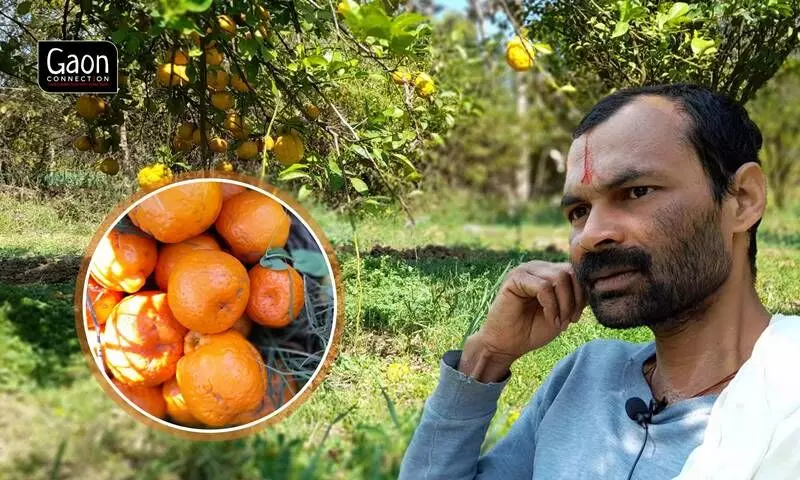A farmer in Madhya Pradesh gives up grain cultivation in order to grow oranges and now reaps better profits
 Sachin Tulsa tripathi 28 Feb 2022 11:17 AM GMT
Sachin Tulsa tripathi 28 Feb 2022 11:17 AM GMT

Satna, Madhya Pradesh
Farmer Tej Narayan Tiwari has earned more than Rs 128,000 from his one-and-a-half-acre orange orchard. The bountiful yield in just January this year alone, of 40 quintals (4,000 kilogram) of orange that he sold at Rs 32 a kilogram, has left him smiling.
Tiwari who lives in Pagar Kala village in Satna district in Birsinghpur tehsil, has 250 orange trees in his 1.5 acres of land. Fed up with the low returns on his paddy and wheat crops, Tiwari changed to cultivating oranges seven years ago. After making the initial investment on his orchard, he is now reaping profits. Tiwari is one of the very few farmers in the region (northeastern hill parts of Madhya Pradesh) to grow oranges.
"It takes about six years for the orange tree to bear fruit. And the number of fruits the trees yield keeps increasing. In my orchards the yield has doubled in just a period of one year," he told Gaon Connection. According to him, in the not too distant future, each tree will bear him a quintal of oranges. "At the moment, I get about fifteen to twenty kgs of oranges per tree," he said.
In the last couple of years, despite the pandemic, Tiwari managed to get 20 quintals of oranges in one harvest which he sold at Rs 20 a kg. It was quite something as that was the first crop of oranges he had harvested.
The switchover
Tiwari's father, Ramlal, many decades ago had worked in orange orchards in Nagpur. About 20 years ago, he had brought ten saplings to see if they would grow in Pagar Kala village. "My father's trial bore fruit and the saplings soon grew into trees. That further encouraged me to change to orange cultivation. I learnt more about how to cultivate them from my father who had so much experience in it," he said.
Seven years ago, Tiwari bought 250 saplings of oranges from Nagpur in Maharashtra, paying Rs 35 per sapling. "It was a struggle initially to ensure the saplings took root well as there was a water problem here, but even then, it was a better alternative to the wheat and paddy I grew earlier," the farmer said.
The soil in Tiwari's village is stony and not that great for cultivation. About half a kilometre from his land is the Bhimphora hills at the foothills of which in about 400 acres of land farmers struggle to grow paddy, wheat, chana, mustard, urad dal, etc.
They end up spending a lot of money on cultivating and often the produce is just enough to feed the farmers and their families, Tiwari said. The farmers often grow vegetables to supplement their income.
While cultivating oranges is not an easy thing and requires a lot of work, unlike the grains it does not need to be irrigated three or four times. "I had no pump and growing paddy and wheat was tough. I had to spend Rs 1,200 per acre to irrigate my land. That always pinched me," he said.
According to Tiwari, in the past five years he might have spent not more than Rs 20,000 on his oranges.
Multi-cropping
While Tiwari grows oranges on one and a half acres of land, in his remaining one and a half acres he cultivates lemons and guavas. In the three metre space between the orange trees, he grows vegetables such as brinjals and tomatoes. He earns about Rs 20,000 by selling his vegetables alone.
"I grow seasonal vegetables, but it is tough with the water scarcity we face here. Sometimes even drinking water is difficult to source," Tiwari said. That is one of the reasons more farmers in the area have changed to the more forgiving orange cultivation.
India is the second highest producer of fruits, vegetables and spices in the world. The country contributes nearly 12 per cent of the world's production of fruits and vegetables. In 2020-21, the country produced an estimated 331 million tonnes of fruits and vegetables.
Orange cultivation is going up in the country. In 2019-20, there were 454,000 hectares under orange cultivation and 6,136 metric tonnes of oranges were harvested. In 2020-21 it is estimated that 462,000 hectares of oranges were cultivated and the production is expected to be nearly 6,026 metric tonnes.
Besides Nagpur in Maharashtra, the other districts in Madhya Pradesh where oranges are grown include Chhindwara, Baitul, Hoshangabad, Shajapur, Nijam, Ratlam and Mandsaur.
According to the website of the Farmers Welfare and Agriculture Development Department, Madhya Pradesh, 43,000 hectares of land are under orange cultivation in the state of which 23,000 hectares are in Chhindwara alone. Currently, the production stands at 12 tonnes per hectare, which when compared to the yield in developed countries falls far short.
According to Rajesh Singh, scientist at the Krishi Vigyan Kendra, the region is not really conducive to growing oranges. "The oranges require more humidity, whereas this is a very dry region," the agriculture scientist, told Gaon Connection.
Read the story in Hindi
agricuture #madhya pradesh
More Stories




